Report: Workforce Composition and Diversity in Australian Firms
VerifiedAdded on 2023/06/05
|8
|1638
|114
Report
AI Summary
This report provides an analysis of workforce composition in Australia, examining the changing demographics and the need for organizations to adapt to a diverse workforce. It explores the impact of factors like gender, race, and generation on the workplace, referencing statistical data and academic research to support its claims. The report highlights the importance of diversity management and inclusive environments for employee engagement and productivity. It discusses challenges faced by managers in creating diverse teams and offers insights on effective strategies. Furthermore, the report reflects on the opportunities and challenges presented by a diverse workforce and concludes with recommendations for future management practices, emphasizing the significance of addressing issues related to gender, sexual orientation, culture, and flexible work arrangements.
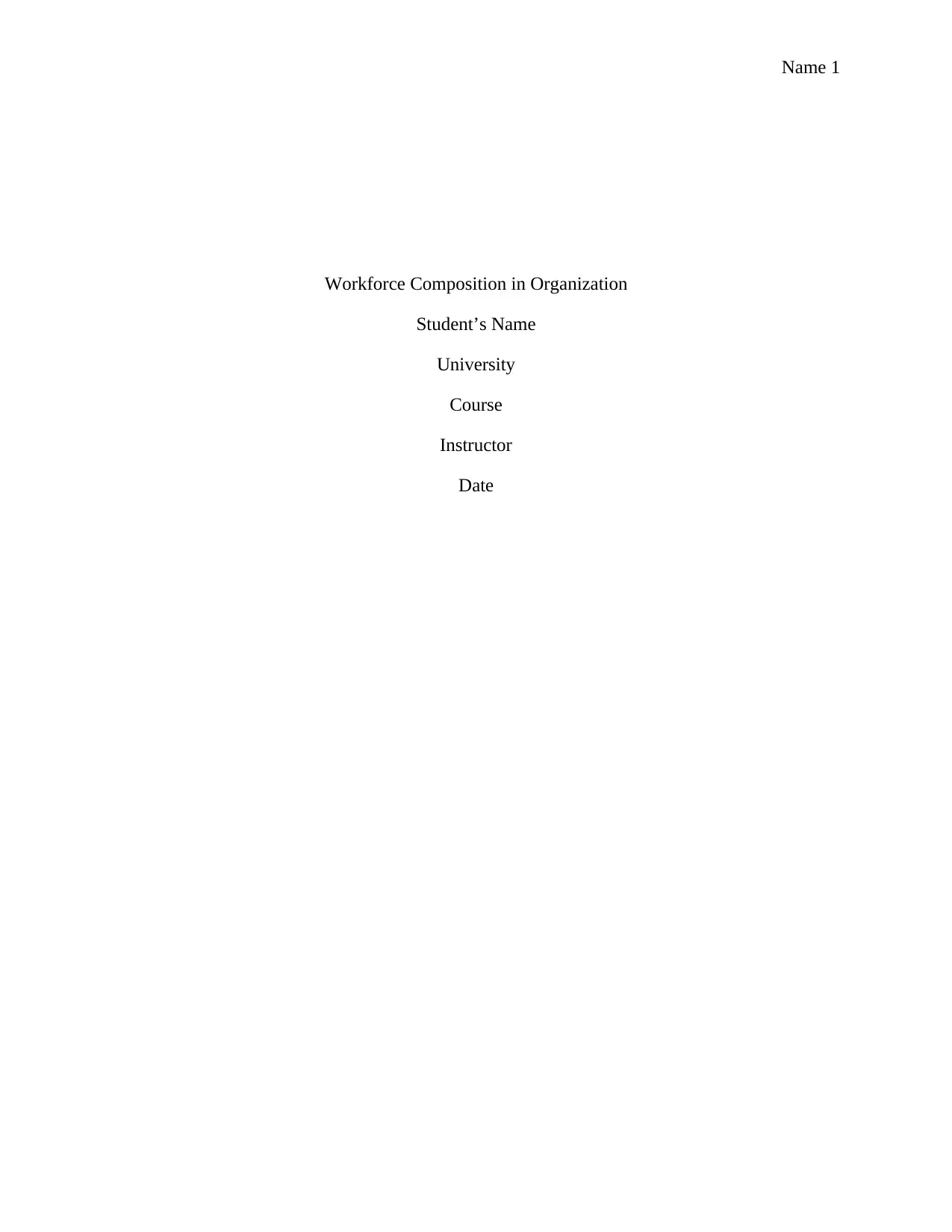
Name 1
Workforce Composition in Organization
Student’s Name
University
Course
Instructor
Date
Workforce Composition in Organization
Student’s Name
University
Course
Instructor
Date
Paraphrase This Document
Need a fresh take? Get an instant paraphrase of this document with our AI Paraphraser

Name 2
Executive summary
Workforce composition entails the demographics and supply of people within the
workplace. The nature of workforce composition has been changing due to the need to
accommodate different characteristics of the population. The Australian workforce has
undergone demographic changes recently due to the developments that the country has seen both
in inclusion and the growing number of the workforce. This report analyses workforce
composition in Australia to understand its characteristics and how managers can work well with
such a workforce.
Executive summary
Workforce composition entails the demographics and supply of people within the
workplace. The nature of workforce composition has been changing due to the need to
accommodate different characteristics of the population. The Australian workforce has
undergone demographic changes recently due to the developments that the country has seen both
in inclusion and the growing number of the workforce. This report analyses workforce
composition in Australia to understand its characteristics and how managers can work well with
such a workforce.

Name 3
Table of Contents
Executive summary.....................................................................................................................................2
Introduction.................................................................................................................................................4
Analysis of workforce composition in Australia.........................................................................................4
Reflection....................................................................................................................................................6
Reference.....................................................................................................................................................7
Table of Contents
Executive summary.....................................................................................................................................2
Introduction.................................................................................................................................................4
Analysis of workforce composition in Australia.........................................................................................4
Reflection....................................................................................................................................................6
Reference.....................................................................................................................................................7
⊘ This is a preview!⊘
Do you want full access?
Subscribe today to unlock all pages.

Trusted by 1+ million students worldwide
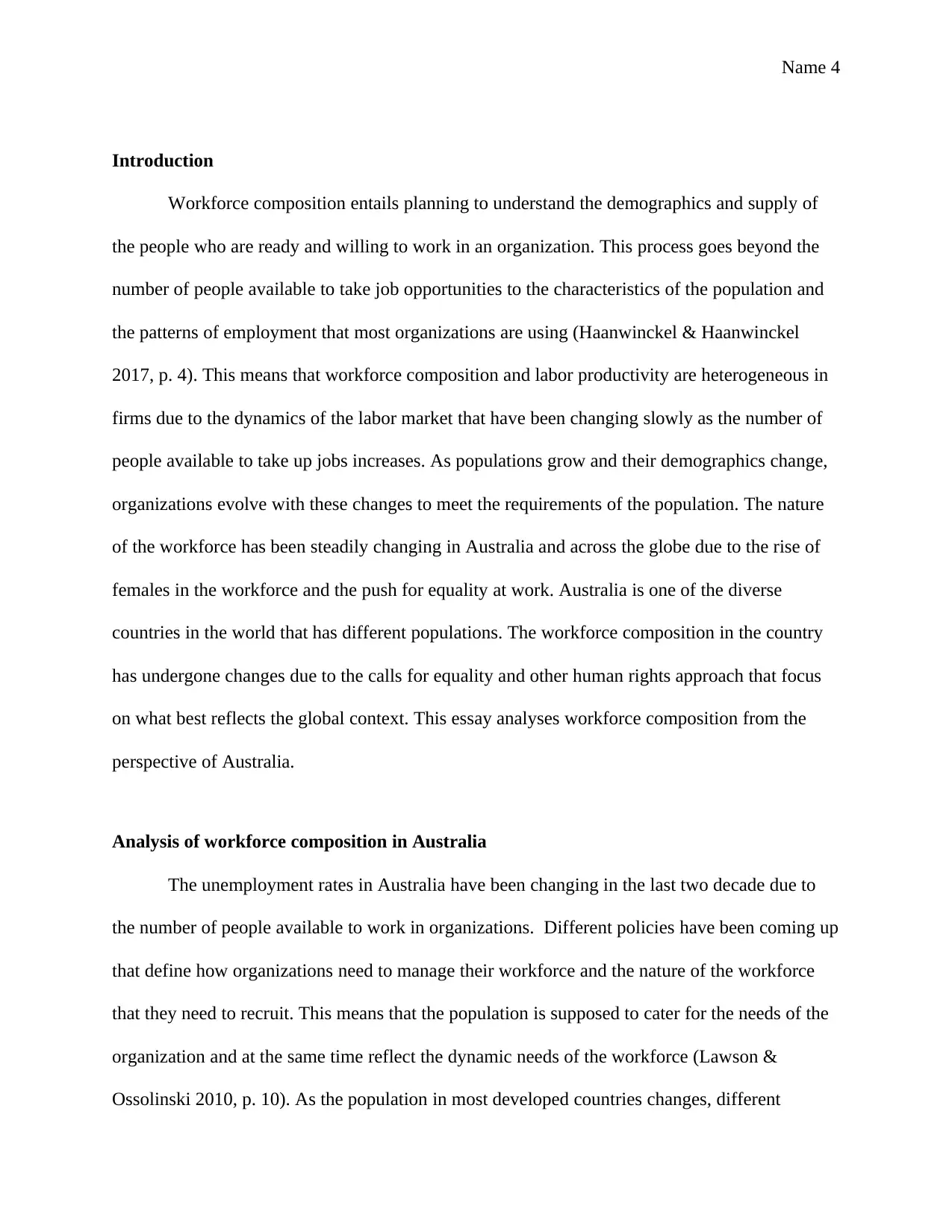
Name 4
Introduction
Workforce composition entails planning to understand the demographics and supply of
the people who are ready and willing to work in an organization. This process goes beyond the
number of people available to take job opportunities to the characteristics of the population and
the patterns of employment that most organizations are using (Haanwinckel & Haanwinckel
2017, p. 4). This means that workforce composition and labor productivity are heterogeneous in
firms due to the dynamics of the labor market that have been changing slowly as the number of
people available to take up jobs increases. As populations grow and their demographics change,
organizations evolve with these changes to meet the requirements of the population. The nature
of the workforce has been steadily changing in Australia and across the globe due to the rise of
females in the workforce and the push for equality at work. Australia is one of the diverse
countries in the world that has different populations. The workforce composition in the country
has undergone changes due to the calls for equality and other human rights approach that focus
on what best reflects the global context. This essay analyses workforce composition from the
perspective of Australia.
Analysis of workforce composition in Australia
The unemployment rates in Australia have been changing in the last two decade due to
the number of people available to work in organizations. Different policies have been coming up
that define how organizations need to manage their workforce and the nature of the workforce
that they need to recruit. This means that the population is supposed to cater for the needs of the
organization and at the same time reflect the dynamic needs of the workforce (Lawson &
Ossolinski 2010, p. 10). As the population in most developed countries changes, different
Introduction
Workforce composition entails planning to understand the demographics and supply of
the people who are ready and willing to work in an organization. This process goes beyond the
number of people available to take job opportunities to the characteristics of the population and
the patterns of employment that most organizations are using (Haanwinckel & Haanwinckel
2017, p. 4). This means that workforce composition and labor productivity are heterogeneous in
firms due to the dynamics of the labor market that have been changing slowly as the number of
people available to take up jobs increases. As populations grow and their demographics change,
organizations evolve with these changes to meet the requirements of the population. The nature
of the workforce has been steadily changing in Australia and across the globe due to the rise of
females in the workforce and the push for equality at work. Australia is one of the diverse
countries in the world that has different populations. The workforce composition in the country
has undergone changes due to the calls for equality and other human rights approach that focus
on what best reflects the global context. This essay analyses workforce composition from the
perspective of Australia.
Analysis of workforce composition in Australia
The unemployment rates in Australia have been changing in the last two decade due to
the number of people available to work in organizations. Different policies have been coming up
that define how organizations need to manage their workforce and the nature of the workforce
that they need to recruit. This means that the population is supposed to cater for the needs of the
organization and at the same time reflect the dynamic needs of the workforce (Lawson &
Ossolinski 2010, p. 10). As the population in most developed countries changes, different
Paraphrase This Document
Need a fresh take? Get an instant paraphrase of this document with our AI Paraphraser
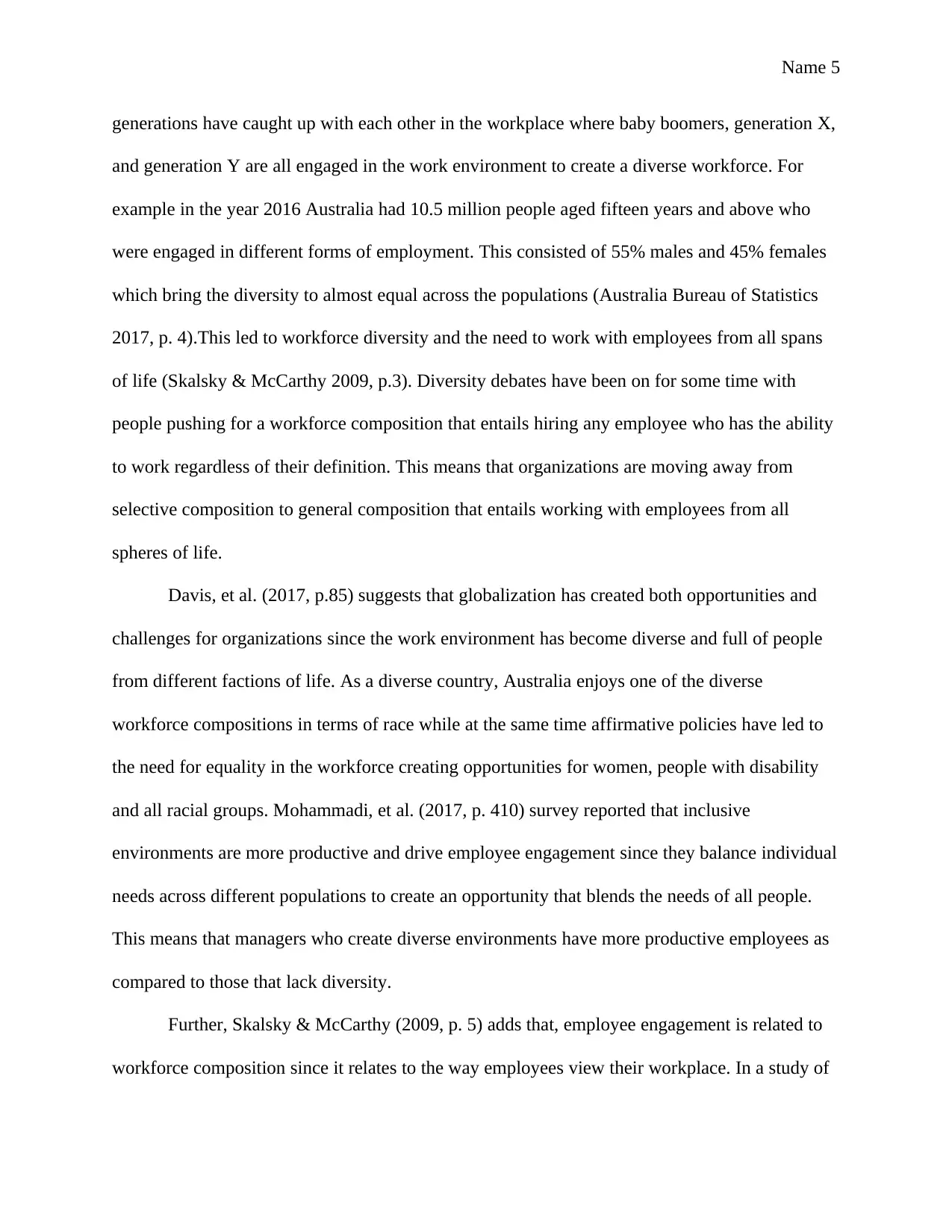
Name 5
generations have caught up with each other in the workplace where baby boomers, generation X,
and generation Y are all engaged in the work environment to create a diverse workforce. For
example in the year 2016 Australia had 10.5 million people aged fifteen years and above who
were engaged in different forms of employment. This consisted of 55% males and 45% females
which bring the diversity to almost equal across the populations (Australia Bureau of Statistics
2017, p. 4).This led to workforce diversity and the need to work with employees from all spans
of life (Skalsky & McCarthy 2009, p.3). Diversity debates have been on for some time with
people pushing for a workforce composition that entails hiring any employee who has the ability
to work regardless of their definition. This means that organizations are moving away from
selective composition to general composition that entails working with employees from all
spheres of life.
Davis, et al. (2017, p.85) suggests that globalization has created both opportunities and
challenges for organizations since the work environment has become diverse and full of people
from different factions of life. As a diverse country, Australia enjoys one of the diverse
workforce compositions in terms of race while at the same time affirmative policies have led to
the need for equality in the workforce creating opportunities for women, people with disability
and all racial groups. Mohammadi, et al. (2017, p. 410) survey reported that inclusive
environments are more productive and drive employee engagement since they balance individual
needs across different populations to create an opportunity that blends the needs of all people.
This means that managers who create diverse environments have more productive employees as
compared to those that lack diversity.
Further, Skalsky & McCarthy (2009, p. 5) adds that, employee engagement is related to
workforce composition since it relates to the way employees view their workplace. In a study of
generations have caught up with each other in the workplace where baby boomers, generation X,
and generation Y are all engaged in the work environment to create a diverse workforce. For
example in the year 2016 Australia had 10.5 million people aged fifteen years and above who
were engaged in different forms of employment. This consisted of 55% males and 45% females
which bring the diversity to almost equal across the populations (Australia Bureau of Statistics
2017, p. 4).This led to workforce diversity and the need to work with employees from all spans
of life (Skalsky & McCarthy 2009, p.3). Diversity debates have been on for some time with
people pushing for a workforce composition that entails hiring any employee who has the ability
to work regardless of their definition. This means that organizations are moving away from
selective composition to general composition that entails working with employees from all
spheres of life.
Davis, et al. (2017, p.85) suggests that globalization has created both opportunities and
challenges for organizations since the work environment has become diverse and full of people
from different factions of life. As a diverse country, Australia enjoys one of the diverse
workforce compositions in terms of race while at the same time affirmative policies have led to
the need for equality in the workforce creating opportunities for women, people with disability
and all racial groups. Mohammadi, et al. (2017, p. 410) survey reported that inclusive
environments are more productive and drive employee engagement since they balance individual
needs across different populations to create an opportunity that blends the needs of all people.
This means that managers who create diverse environments have more productive employees as
compared to those that lack diversity.
Further, Skalsky & McCarthy (2009, p. 5) adds that, employee engagement is related to
workforce composition since it relates to the way employees view their workplace. In a study of
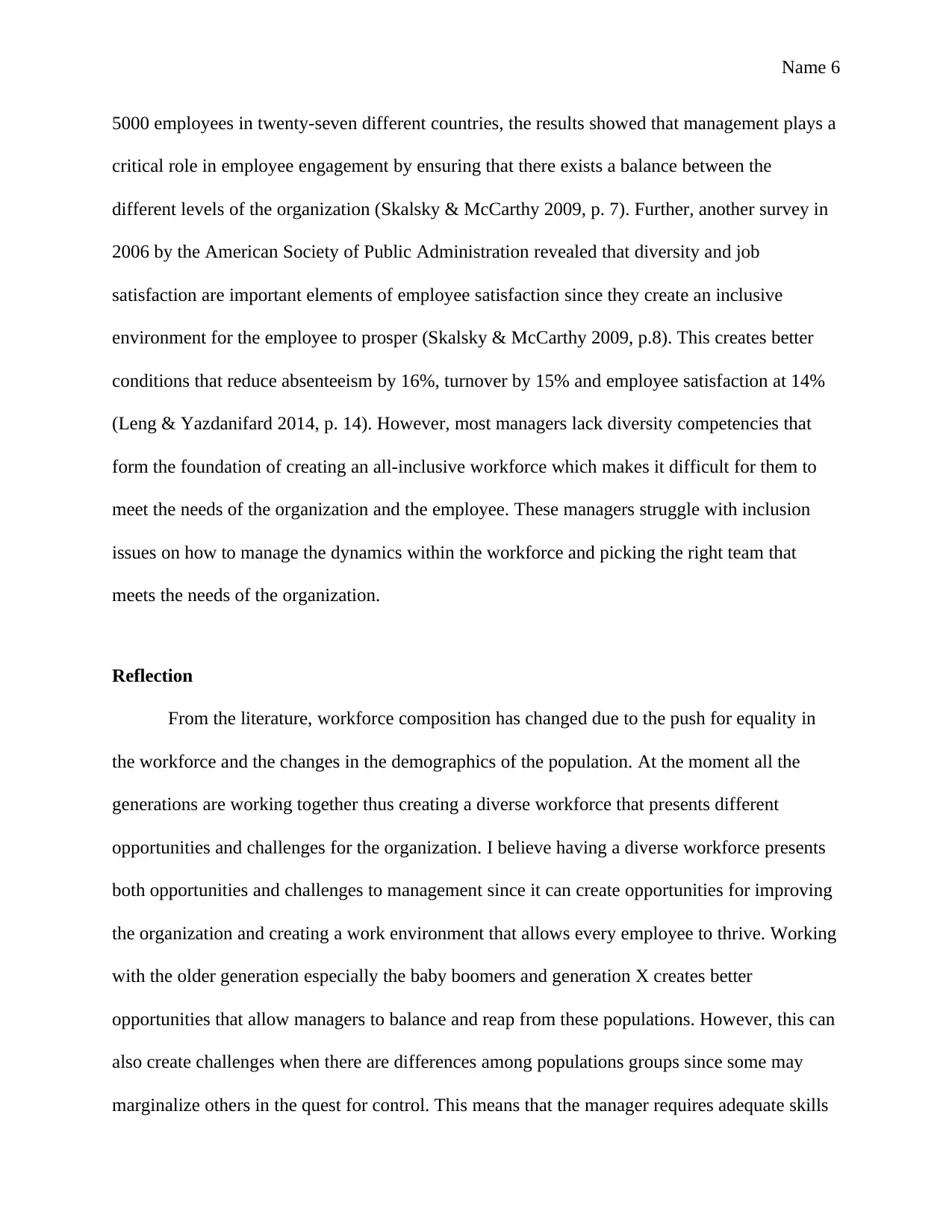
Name 6
5000 employees in twenty-seven different countries, the results showed that management plays a
critical role in employee engagement by ensuring that there exists a balance between the
different levels of the organization (Skalsky & McCarthy 2009, p. 7). Further, another survey in
2006 by the American Society of Public Administration revealed that diversity and job
satisfaction are important elements of employee satisfaction since they create an inclusive
environment for the employee to prosper (Skalsky & McCarthy 2009, p.8). This creates better
conditions that reduce absenteeism by 16%, turnover by 15% and employee satisfaction at 14%
(Leng & Yazdanifard 2014, p. 14). However, most managers lack diversity competencies that
form the foundation of creating an all-inclusive workforce which makes it difficult for them to
meet the needs of the organization and the employee. These managers struggle with inclusion
issues on how to manage the dynamics within the workforce and picking the right team that
meets the needs of the organization.
Reflection
From the literature, workforce composition has changed due to the push for equality in
the workforce and the changes in the demographics of the population. At the moment all the
generations are working together thus creating a diverse workforce that presents different
opportunities and challenges for the organization. I believe having a diverse workforce presents
both opportunities and challenges to management since it can create opportunities for improving
the organization and creating a work environment that allows every employee to thrive. Working
with the older generation especially the baby boomers and generation X creates better
opportunities that allow managers to balance and reap from these populations. However, this can
also create challenges when there are differences among populations groups since some may
marginalize others in the quest for control. This means that the manager requires adequate skills
5000 employees in twenty-seven different countries, the results showed that management plays a
critical role in employee engagement by ensuring that there exists a balance between the
different levels of the organization (Skalsky & McCarthy 2009, p. 7). Further, another survey in
2006 by the American Society of Public Administration revealed that diversity and job
satisfaction are important elements of employee satisfaction since they create an inclusive
environment for the employee to prosper (Skalsky & McCarthy 2009, p.8). This creates better
conditions that reduce absenteeism by 16%, turnover by 15% and employee satisfaction at 14%
(Leng & Yazdanifard 2014, p. 14). However, most managers lack diversity competencies that
form the foundation of creating an all-inclusive workforce which makes it difficult for them to
meet the needs of the organization and the employee. These managers struggle with inclusion
issues on how to manage the dynamics within the workforce and picking the right team that
meets the needs of the organization.
Reflection
From the literature, workforce composition has changed due to the push for equality in
the workforce and the changes in the demographics of the population. At the moment all the
generations are working together thus creating a diverse workforce that presents different
opportunities and challenges for the organization. I believe having a diverse workforce presents
both opportunities and challenges to management since it can create opportunities for improving
the organization and creating a work environment that allows every employee to thrive. Working
with the older generation especially the baby boomers and generation X creates better
opportunities that allow managers to balance and reap from these populations. However, this can
also create challenges when there are differences among populations groups since some may
marginalize others in the quest for control. This means that the manager requires adequate skills
⊘ This is a preview!⊘
Do you want full access?
Subscribe today to unlock all pages.

Trusted by 1+ million students worldwide
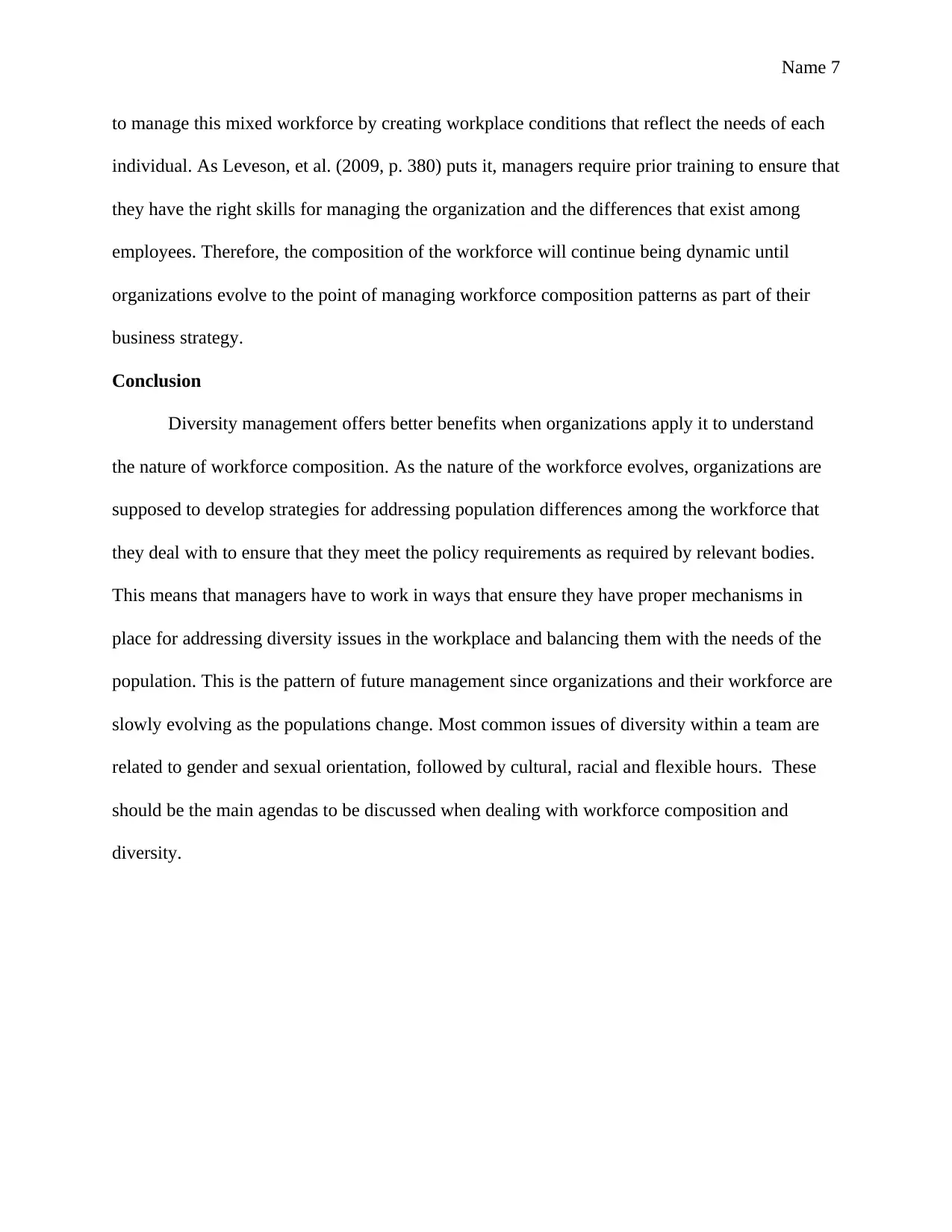
Name 7
to manage this mixed workforce by creating workplace conditions that reflect the needs of each
individual. As Leveson, et al. (2009, p. 380) puts it, managers require prior training to ensure that
they have the right skills for managing the organization and the differences that exist among
employees. Therefore, the composition of the workforce will continue being dynamic until
organizations evolve to the point of managing workforce composition patterns as part of their
business strategy.
Conclusion
Diversity management offers better benefits when organizations apply it to understand
the nature of workforce composition. As the nature of the workforce evolves, organizations are
supposed to develop strategies for addressing population differences among the workforce that
they deal with to ensure that they meet the policy requirements as required by relevant bodies.
This means that managers have to work in ways that ensure they have proper mechanisms in
place for addressing diversity issues in the workplace and balancing them with the needs of the
population. This is the pattern of future management since organizations and their workforce are
slowly evolving as the populations change. Most common issues of diversity within a team are
related to gender and sexual orientation, followed by cultural, racial and flexible hours. These
should be the main agendas to be discussed when dealing with workforce composition and
diversity.
to manage this mixed workforce by creating workplace conditions that reflect the needs of each
individual. As Leveson, et al. (2009, p. 380) puts it, managers require prior training to ensure that
they have the right skills for managing the organization and the differences that exist among
employees. Therefore, the composition of the workforce will continue being dynamic until
organizations evolve to the point of managing workforce composition patterns as part of their
business strategy.
Conclusion
Diversity management offers better benefits when organizations apply it to understand
the nature of workforce composition. As the nature of the workforce evolves, organizations are
supposed to develop strategies for addressing population differences among the workforce that
they deal with to ensure that they meet the policy requirements as required by relevant bodies.
This means that managers have to work in ways that ensure they have proper mechanisms in
place for addressing diversity issues in the workplace and balancing them with the needs of the
population. This is the pattern of future management since organizations and their workforce are
slowly evolving as the populations change. Most common issues of diversity within a team are
related to gender and sexual orientation, followed by cultural, racial and flexible hours. These
should be the main agendas to be discussed when dealing with workforce composition and
diversity.
Paraphrase This Document
Need a fresh take? Get an instant paraphrase of this document with our AI Paraphraser
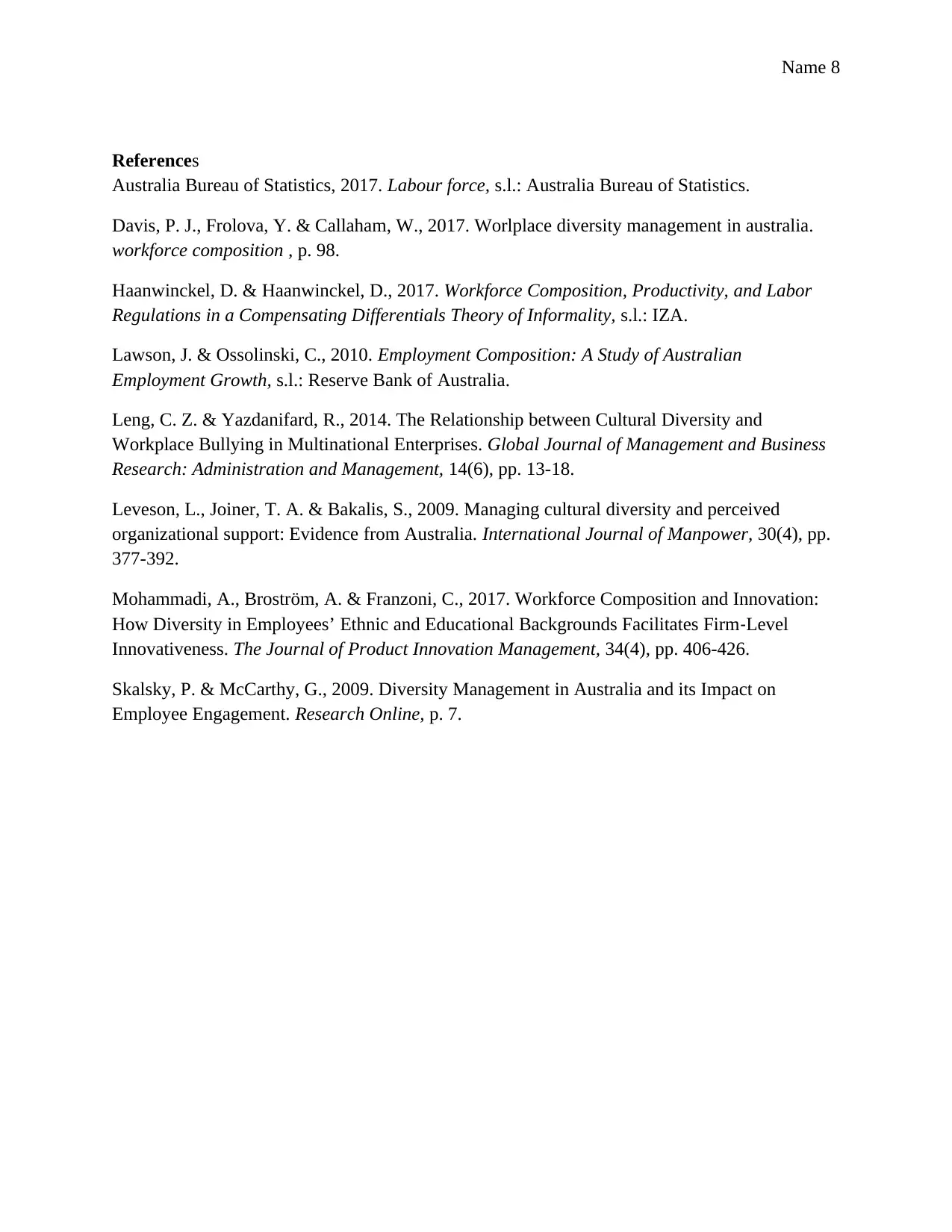
Name 8
References
Australia Bureau of Statistics, 2017. Labour force, s.l.: Australia Bureau of Statistics.
Davis, P. J., Frolova, Y. & Callaham, W., 2017. Worlplace diversity management in australia.
workforce composition , p. 98.
Haanwinckel, D. & Haanwinckel, D., 2017. Workforce Composition, Productivity, and Labor
Regulations in a Compensating Differentials Theory of Informality, s.l.: IZA.
Lawson, J. & Ossolinski, C., 2010. Employment Composition: A Study of Australian
Employment Growth, s.l.: Reserve Bank of Australia.
Leng, C. Z. & Yazdanifard, R., 2014. The Relationship between Cultural Diversity and
Workplace Bullying in Multinational Enterprises. Global Journal of Management and Business
Research: Administration and Management, 14(6), pp. 13-18.
Leveson, L., Joiner, T. A. & Bakalis, S., 2009. Managing cultural diversity and perceived
organizational support: Evidence from Australia. International Journal of Manpower, 30(4), pp.
377-392.
Mohammadi, A., Broström, A. & Franzoni, C., 2017. Workforce Composition and Innovation:
How Diversity in Employees’ Ethnic and Educational Backgrounds Facilitates Firm‐Level
Innovativeness. The Journal of Product Innovation Management, 34(4), pp. 406-426.
Skalsky, P. & McCarthy, G., 2009. Diversity Management in Australia and its Impact on
Employee Engagement. Research Online, p. 7.
References
Australia Bureau of Statistics, 2017. Labour force, s.l.: Australia Bureau of Statistics.
Davis, P. J., Frolova, Y. & Callaham, W., 2017. Worlplace diversity management in australia.
workforce composition , p. 98.
Haanwinckel, D. & Haanwinckel, D., 2017. Workforce Composition, Productivity, and Labor
Regulations in a Compensating Differentials Theory of Informality, s.l.: IZA.
Lawson, J. & Ossolinski, C., 2010. Employment Composition: A Study of Australian
Employment Growth, s.l.: Reserve Bank of Australia.
Leng, C. Z. & Yazdanifard, R., 2014. The Relationship between Cultural Diversity and
Workplace Bullying in Multinational Enterprises. Global Journal of Management and Business
Research: Administration and Management, 14(6), pp. 13-18.
Leveson, L., Joiner, T. A. & Bakalis, S., 2009. Managing cultural diversity and perceived
organizational support: Evidence from Australia. International Journal of Manpower, 30(4), pp.
377-392.
Mohammadi, A., Broström, A. & Franzoni, C., 2017. Workforce Composition and Innovation:
How Diversity in Employees’ Ethnic and Educational Backgrounds Facilitates Firm‐Level
Innovativeness. The Journal of Product Innovation Management, 34(4), pp. 406-426.
Skalsky, P. & McCarthy, G., 2009. Diversity Management in Australia and its Impact on
Employee Engagement. Research Online, p. 7.
1 out of 8
Related Documents
Your All-in-One AI-Powered Toolkit for Academic Success.
+13062052269
info@desklib.com
Available 24*7 on WhatsApp / Email
![[object Object]](/_next/static/media/star-bottom.7253800d.svg)
Unlock your academic potential
Copyright © 2020–2025 A2Z Services. All Rights Reserved. Developed and managed by ZUCOL.




